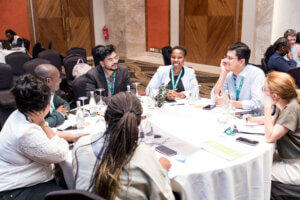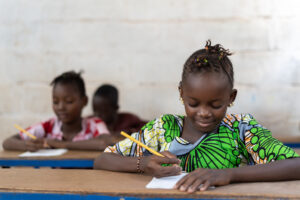Supporting safe environments for learners: takeaways from GSF’s recent Community of Practice on child safeguarding.
All children have the right to protection from violence, yet over 1 billion children every year experience physical, sexual or emotional violence at home, in school, on the way to school, or online. Violence in and around schools negatively impacts children’s lives and well-being, undermining their development. According to the World Bank, the cost of violence against children for society is estimated at USD $11 trillion in lost lifetime earnings. Research shows that this violence is preventable in low- and middle-income contexts, particularly when involving school staff, management, students, families and community members.
GSF recently wrapped up a Community of Practice (CoP) on child safeguarding where practitioners from more than 10 organisations from diverse contexts came together to connect, build skills and share tools and expertise emerging from their work. This blog shares five key learnings from the CoP.
Overcoming cultural barriers to supporting safe environments for students
Implementing a child safeguarding policy in low- and middle-income contexts often requires introducing new ideas and practices, which may contradict established norms. In various contexts, such norms can pose significant challenges to students’ rights, safety and well-being. For instance, 793 million school-age children live in countries where corporal punishment in school is legal. In low- and middle-income countries, corporal punishment is common even in places where it has been banned. Such norms hinder efforts to introduce more positive approaches to behaviour management in school. In some places, reporting safeguarding concerns can be risky for whistle-blowers who face threats when raising a possible concern. In these cases, schools and organisations must thoughtfully and proactively plan to cultivate a culture of reporting, while ensuring that informants themselves are protected from harm.
Leaders participating in our recent community of practice highlighted the importance of culturally sensitive and creative approaches to discuss, and where necessary, change behaviours related to sensitive or taboo topics. The use of local stories and examples to explain safeguarding concepts and procedures, developing locally adapted versions of safeguarding policies and ensuring policies and associated materials are translated into local languages may help promote social norms and behaviours which support safe environments for students.
Empowering schools and leaders to drive safeguarding in their contexts
Child safeguarding is not a one-off task – it requires continuous leadership and commitment from individuals across an organisation, especially at the school level. In particular, existing research highlights the importance of full involvement from school leaders as an essential component of reducing violence against children. Our Community of Practice explored this question in depth – how can leaders and teachers be supported to drive safeguarding in their schools and classrooms?
For instance, we heard from PEAS on the PEAS Safeguarding Standards – a set of 22 standards that help schools and leaders address common safeguarding challenges by focusing on essential practices aligned to global best practice. At PEAS, the Safeguarding Standards have helped transfer ownership of safeguarding to schools, supporting school leaders to action plan against the Standards, holding themselves to account for their progress. By empowering school leaders to lead safeguarding, as modelled by PEAS, we can build capacity and create shared accountability for keeping students safe.
Safeguarding beyond the school setting
As school network operators and education support organisations, our primary focus when it comes to children’s safety is the school environment. However, in low- and middle-income countries, children face vulnerabilities that often extend beyond the school gates. This raises an important question: what is our role and obligation in these broader contexts?
Beyond reporting incidents to local authorities, organisations must decide which activities to prioritise. This can be an overwhelming task, especially in vulnerable contexts with limited support and few organisations available to provide support to students. Research shows that whole school approaches, which involve parents, have been effective towards reducing violence against children.
At a minimum, ensuring that parents and the wider community fully understand your organisation and/or school’s safeguarding procedures, including when and how to report concerns is important. During the Community of Practice, BRAC shared that routine teacher-led meetings provide an effective platform for sharing safeguarding policies and reporting procedures with parents, as part of a broader suite of safeguarding initiatives. Establishing relationships with local external organisations, where possible, is vital for providing comprehensive support to students who may be impacted by abuse.
Cultivating a culture where reporting is the norm, not an exception
Research shows that the vast majority of child abuse cases go unreported. To address this, implementing reporting tools and procedures that are clear, well communicated and encourage prompt reporting from staff and stakeholders is important. Fostering a culture where stakeholders feel safe and empowered to report concerns is equally crucial.
During the Community of Practice, we heard from EducAid on the Five-Minute Rule, where students and staff are expected to report possible safeguarding concerns within five minutes. The Five-Minute Rule has led to an uptick in safeguarding concerns reported, which EducAid prides as a sign of the rule’s effectiveness. Success is attributed to simple messaging and regular refresher trainings to reinforce effective reporting practice and create shared understanding of the rule among stakeholders.
At Enko Education, a reporting flow chart and collaborative safeguarding reporting tool has supported implementation of safeguarding reporting procedures across Enko’s 14 schools in 9 countries. The system allows multiple stakeholders to update information in real time, ensuring those involved have the most up-to-date information and can act quickly. Continuous training for school-level leaders has been crucial. Once a safeguarding concern has been received, a Case Assessment Form can support teams to gather additional information about the concern including details of the incident, statements from witnesses, changes in child behaviour, and any potential conflict of interest.
We know from existing data that many children do not feel comfortable reporting safety concerns. EducAid’s Ami & Ally videos and the Safety in Five rule are examples of child-friendly approaches which can support children to raise concerns. By making the reporting process accessible for children and cultivating a culture where reporting (even among children) is the expectation, we can build school environments which are truly safe for all students.
Striving towards the international child safeguarding benchmarks
In the diverse and challenging contexts where our members operate, the safeguarding journey is ongoing and constantly evolving. Working towards meeting the International Child Safeguarding Standards is not a one-time effort but a continuous process that requires sustained commitment and action, and often ongoing training and support for stakeholders and teams. This ongoing journey requires assessing current practice and emerging risks and developing plans for tackling gaps. This is where the Safeguarding Self-Assessment Tool, Action Planning Template and Safeguarding Risk Assessment can be helpful resources for safeguarding auditing and planning, at both the school and network level.
In addition, continuous monitoring of progress on safeguarding is essential. At PEAS, for example, the PEAS’ Monitoring Tool helps track and measure progress towards the PEAS Safeguarding Standards. At Rising Academies, a data dashboard helps track safeguarding progress across key indicators aligned to essential safeguarding practices. Regular review meetings where stakeholders come together and review action plans and progress towards safeguarding goals can help foster a culture of continuous improvement on safeguarding.
Looking ahead
We are looking forward to continuing this journey with our community in the months ahead. Please stay tuned for our forthcoming updated Child Safeguarding Toolkit, where we’ll be sharing new tools, resources and case studies to support your journey in keeping children safe.
If you have a safeguarding practice or tool that you feel organisations in the GSF community could benefit from, please reach out. Through connection, sharing and exchange of ideas, tools and expertise, together we’re supporting safe environments for students.
The Community of Practice on child safeguarding was led by Kaitlynn Saldanha and this blog is also authored by Kaitlynn.







 Child Safeguarding
Child Safeguarding





